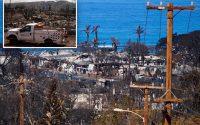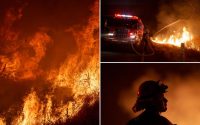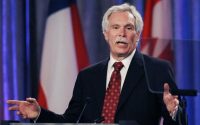Is the US rail system on the wrong track
As the village of East Palestine, Ohio, contended with the aftermath of last month’s train derailment and environmental contamination, residents in South Florida endured their own rail scare this past week.
On Tuesday afternoon, just outside of Sarasota, five cars from a Southern Gulf Railroad freight train — two of which carried 30,000 gallons of propane — derailed in Gulf Coast Manatee County, right near an industrial park and the Sarasota Bradenton International Airport.
Fortunately, when first responders arrived at the scene, they were relieved to find no leak.
“The potential for a 30,000-gallon explosion of liquid propane is pretty significant,” South Manatee Fire Rescue Chief Robert Bounds told the Post.
With no injuries or chemicals to remove, it was a remarkably positive outcome for a potentially calamitous scare. But coming on the heels of the disaster in East Palestine — along with another freight derailment last weekend in North Carolina — the Florida accident is just the latest proof the US rail system is due for an upgrade.

According to a preliminary report from the National Transportation Safety Board (NTSB), the Feb. 3 Norfolk Southern train derailment in East Palestine appears to have been caused by an overheated wheel bearing. Nearly a dozen cars carrying hazardous materials derailed, which ignited fires that spread to additional carriages.
Despite repeated tests and reassurances from EPA officials and Gov. Mike DeWine (R-Ohio) that their drinking water is safe, many local residents have complained of symptoms reminiscent of chemical exposure.
And the resulting finger-pointing, at once partisan and contradictory, demonstrates the potential for disarray in an industry that while operating under public oversight, remains mostly privately owned.

Republicans, for instance, have criticized the Biden administration’s response as slow, with Senate Commerce Committee Ranking Member Sen. Ted Cruz (R-Texas) accusing Transportation Secretary Pete Buttigieg of “ignoring” the crisis and merely responding with a “grab-bag of policy proposals” he characterized as “irrelevant.”
Biden administration officials, meanwhile, have pointed to past lawsuits and lobbying from railroad industry leaders to fight would-be safety measures, specifically a regulation surrounding electronically controlled pneumatic braking systems for trains carrying large amounts of highly flammable material.
While both sides may have merit, the finger-pointing has only fueled confusion. “There’s a lot of political posturing,” Allan Zarembski, director of the Railway Engineering and Safety Program at the University of Delaware, told The Post.
While Zarembski notes that train derailments are quite common, those of the scope witnessed in Ohio is, as he put it, “very unusual.” Indeed, between 1990 and 2021, more than 54,000 trains derailed nationwide, according to Bureau of Transportation Statistics data reviewed by The Post — with between 1,000 and 1,400 each year dating back to 2012.
Most of those, Zarembski said, is akin to rail yard “fender benders,” with injuries occurring in just a small percentage of derailments. But concerns about safety have, indeed, grown louder — and not just from the White House or Senate.
So while another derailment on the scale of East Palestine is unlikely in the near term, demands for long-term industry scrutiny can no longer be ignored.

In an April 2022 memo, Martin Oberman, chairman of the Surface Transportation Board, a federal regulator, raised concerns about major rail companies like Norfolk Southern, CSX, and others cutting their workforces to “bare bones” to satisfy shareholders — citing staffing levels down 29% from just six years earlier.
Major freight rail unions similarly raised concerns last fall about safety and working conditions amid a contract dispute and near-strike. For some industry insiders, both groups were merely stating the obvious.
“The actual reality is, that railroading is not as safe as it could or should be,” Jim Mathews, CEO of the Rail Passengers Association and member of multiple congressional committees dealing with rail and passenger safety and hazardous materials, told The Post.

“It’s super-long trains, very thin crews … maximum profit, maximum margin,” he added. “And that’s just kind of a climate where, no, you’re not necessarily violating the rules, but…you’re just taking every opportunity to cut corners.”
Clearly, more money could help, and there’s plenty on the table. The 2021 bipartisan infrastructure law earmarked close to $70 billion for rail improvements, some of which will likely go toward safety upgrades.
But with the majority of the nation’s rail system actually owned by private companies like Norfolk Southern, Mathews questions whether taxpayers should be on the hook for the lion’s share of major improvements.
Indeed, refining this public-private pas de deux could be at the heart of any eventual industry overhaul.

Despite the trio of recent accidents, rail carriers continue to insist their systems are safe. According to the freight rail industry’s principal lobbying arm, the American Association of Railroads (AAR), some 99.9% of hazmat shipments arrive without a problem.
Yet this is of little consolation to the folks in East Palestine, whose health concerns are certain to take center stage on Capitol Hill when Norfolk Southern CEO Alan Shaw testifies before a Senate committee on March 9.
In the meantime, signs of needed oversight reforms have already emerged, such as a new bipartisan rail safety bill introduced on Thursday.
Additionally, major freight railroads — including Norfolk Southern — will now participate in a close-call reporting system which they had previously refused to join.

Still, in the wake of a derailment that he admits, “scared the hell out of us,” Manatee County, Fla., Commission Chairman Kevin Van Ostenbridge suggests the biggest obstacle to improving railway safety isn’t merely a matter of politics — but political head-burying. “I think for a lot of leaders, these trains are out of sight, out of mind,” Van Ostenbridge told The Post.
With the fallout from East Palestine certain to remain in the headlines for months to come, politicians and rail industry execs will now have little choice but to face train safety head-on.


